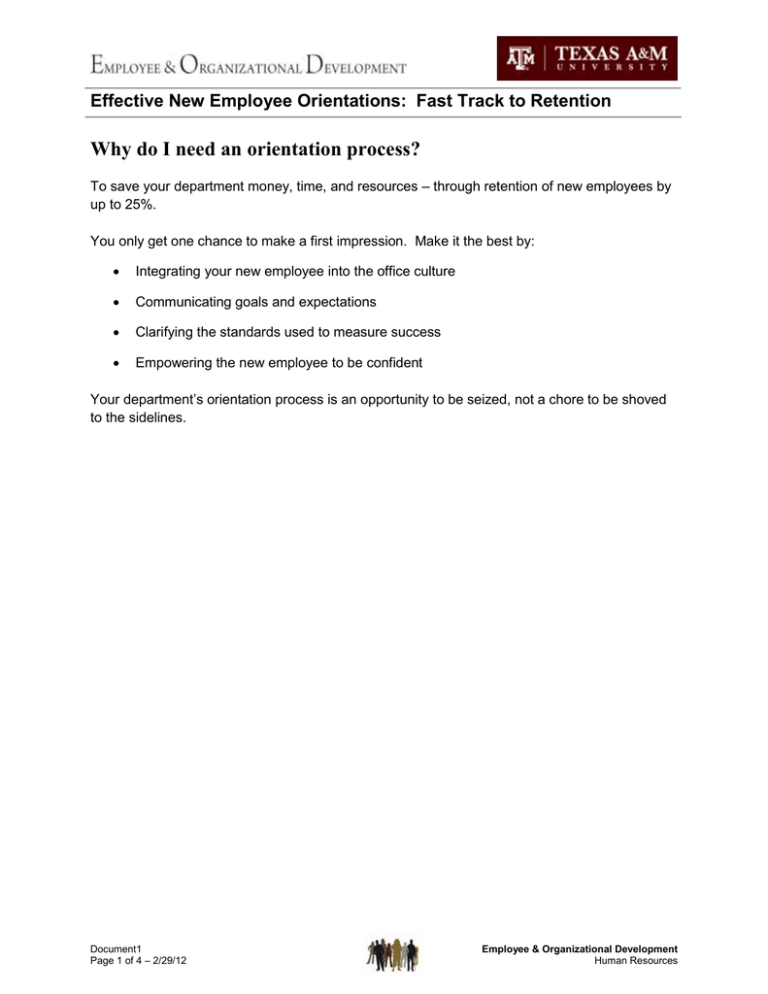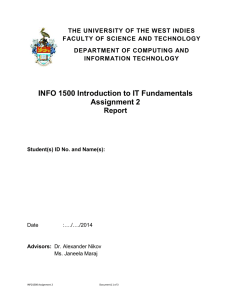Why do I need an orientation process?
advertisement

Effective New Employee Orientations: Fast Track to Retention Why do I need an orientation process? To save your department money, time, and resources – through retention of new employees by up to 25%. You only get one chance to make a first impression. Make it the best by: Integrating your new employee into the office culture Communicating goals and expectations Clarifying the standards used to measure success Empowering the new employee to be confident Your department’s orientation process is an opportunity to be seized, not a chore to be shoved to the sidelines. Document1 Page 1 of 4 – 2/29/12 Employee & Organizational Development Human Resources What goes into an orientation process? Effective Weak Is ongoing, even up to six months or more Ends after the first day Builds relationships and integrates the new employee into the department Only includes the required paperwork Shows genuine excitement – by the whole department – that the new employee has joined the department Is planned ahead in detail Leaves the new employee somewhere, ignored until someone “has a minute” to talk to them Is made up as you go along, leaving huge gaps in engagement and involvement Includes a mixture of media and methods, intensity, and levels of engagement Hands the new employee a thick stack of manuals and literature for them to read Includes current videos and presentations that are relevant and concise Overwhelms the new employee with facts, figures, names, and irrelevant lectures Includes mission, vision, values, and history of the whole organization. Ignores the organizational culture. Builds in periodic review segments throughout the entire orientation period Expects the new employee to remember everything, the first time around Provides a workplace buddy to help guide them through the departmental culture and basic work routines Expects the new employee to know everything already, including who to ask when they need help Document1 Page 2 of 4 – 2/29/12 Employee & Organizational Development Human Resources Some simple things that can be done: Before the new employee begins: Prepare the required paperwork and other administrative details. When possible, complete the paperwork before the start date. Pre-plan any training needs and schedule the training. Write an agenda of what can be expected during the first three months on the job. Hang a welcome banner on office door of the new employee. Assign each new employee a Workplace Buddy. Create a “Welcome Aboard” letter and have it signed by everyone on staff. Mail the “Welcome Aboard” letter to the home of the new employee before they start. Distribute an announcement to current staff and include some details about the new employee; include a photograph of him or her. On the first day and in the first week: Greet the new employee in person – by the immediate supervisor. Review a current job description on the first day to avoid an embarrassment over misunderstandings. Give your new employee a card with the names of everyone who works in the department. Give new employees a "passport'' and assign a certain number of days in which they should get their passport stamped (signed by everyone in the department). Provide shirts or promotional items with your department name on them. Plan a welcome lunch for the new employee, just like the kind we give when employees leave the department. Provide a video that includes all the current employees giving a personal introduction. Provide a glossary of your department (and Texas A&M University) with abbreviations, acronyms, or buzzwords. Beyond the first week and ongoing: Ensure the new employee has met everyone, including other staff members who might have been absent earlier. Document1 Page 3 of 4 – 2/29/12 Employee & Organizational Development Human Resources Demonstrate all office equipment and provide clear instructions, including who to contact for help. Provide the already written agenda (proposed above) to help both the manager and the new employee stay focused on the expectations of the job during the first three months. Meet with the new employee to evaluate progress and determine addition training that may be needed. Document1 Page 4 of 4 – 2/29/12 Employee & Organizational Development Human Resources
